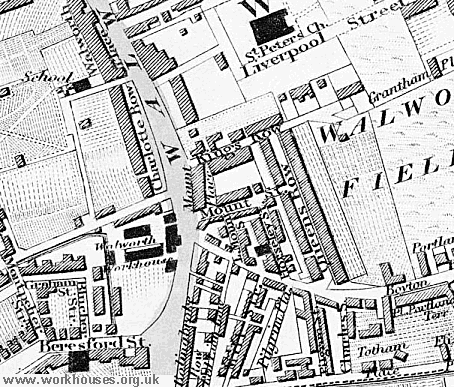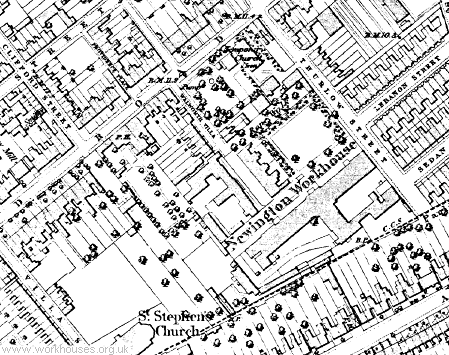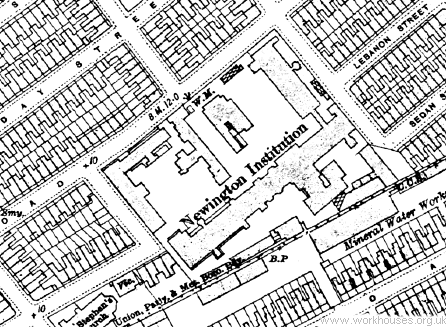Newington St Mary, Surrey, London
Up to 1834
The parish of St Mary Newington opened its first workhouse in around 1734. A parliamentary report of 1777 recorded a workhouse at Newington able to accommodate up to 200 inmates.
In 1814, the parish obtained a local Act of parliament allowing it to establish a body known as the Governors and Guardians of the Poor for collecting and administering the poor rate and raise money for "rebuilding or repairing the workhouse" which was "insufficient for the accommodation and proper employment of the poor". An 1830 map shows the layout of the workhouse which was located at the west side of Walworth Road.

Newington workhouse site, 1830.
After 1834
St Mary, Newington, including the hamlet of Walworth, was constituted as a Poor Law Parish on 9th May, 1836. Its operation was to be overseen by an elected Board of 18 Guardians. The population falling within the Parish at the 1831 census had been 44,526. The average annual poor-rate expenditure for the period 1833-35 had been £18,348 or 8s.3d. per head of the population. Following a legal ruling in January 1837, however, the parish's Local Act was judged to place it outside the 1834 Poor Law Amendment Act and it continued to operate as a Local Act Parish and using the old Walworth Road workhouse.
In 1850, the parish erected an industrial school at the south side of Westmoreland Road in Walworth. After it was completed, the Guardians decided to instead place the children at the North Surrey District School and use the new building to house adult paupers. Its location is shown on the map of 1875 below:

Newington workhouse site, 1875.
In 1868, the recently formed Metropolitan Asylums Board set up six new Sick Asylum Districts for the purposes of providing hospital care for the poor on separate sites from workhouses. One of the new Districts, named Newington, comprised the St Saviour Union and the parishes of St George-the-Martyr, Southwark, and St Mary, Newington. However, the new hospital required by the new scheme was felt to be too expensive and, instead, the Newington Sick Asylum District was reconstituted as an enlarged St Saviour Poor Law Union of which St Mary, Newington, then became part.
The enlarged union redeployed its existing sites to provide the separate workhouse and hospital accommodation that was required. The Westmoreland Road site was initially used as an infirmary. Its layout is shown on the 1876 map below.

Newington workhouse site, 1876.
The main building, at the south of the site, was a T-shaped layout with male inmates housed at the west and females at the east. At the centre were the dining hall and kitchens, with a laudry to the rear on the female side. A bakehouse and work-rooms lay at the rear on the male side A smaller complex of buildings to the north-west contained futher sick wards and lock (venereal) wards, together with a mortuary and casual wards for the overnight accommodation of vagrants.
In 1896, future star of the silent screen Charles Chaplin (then aged seven) briefly became an inmate of the Newington workhouse, together with his mother, Hannah, and his older half-brother Sydney. They went through the usual admissions procedure of being separated from their mother, the children having their hair cut short, and the workhouse uniform replacing their own clothes which were steamed and put into store. After three weeks, the two children were then transferred to the Central London District School at Hanwell. Two months later, the children were returned to the workhouse where they were met at the gate by Hannah, dressed in her own clothes. In desperation to see them, she had discharged herself from the workhouse, along with the children. After a day spent playing in Kennington park and visiting a coffee-shop, they returned to the workhouse and had to go through the whole admissions procedure once more, with the children again staying there for a probationary period before returning to Hanwell.
Some of neighbouring properties were gradually absorbed into the site as shown on the 1916 map below.

Newington workhouse site, 1916.
After 1930, the workhouse became Newington Lodge Public Assistance Institution under the control of the London County Council. The premises were later used as short-term accommodation for homeless families and appeared in the 1966 television play Cathy Come Home. The buildings no longer exist.
Staff
Inmates
Records
Note: many repositories impose a closure period of up to 100 years for records identifying individuals. Before travelling a long distance, always check that the records you want to consult will be available.
-
The
Ancestry UK
website has two collections of London workhouse records (both name searchable):
- Westminster workhouse records are available on FindMyPast, .
- London Metropolitan Archives, 40 Northampton Road, London EC1R OHB. Holdings include: Guardians' minute books (1869-70); Births (1888-1930); Deaths (1888-1906); Creed register (1848-72, 1877-1930); Admissions and discharges (1851-1930); etc.
Bibliography
- Higginbotham, Peter Workhouses of London and the South East (2019)
- Chaplin, Charles (1964) My Autobiography (Bodley Head: London)
Links
- None.
Unless otherwise indicated, this page () is copyright Peter Higginbotham. Contents may not be reproduced without permission.


